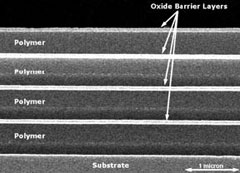Coating | The Movement Toward Thinner Films and Coatings
- Published: July 31, 2012, By Todd Arndorfer, Carestream Tollcoating
As consumer and industrial products continue to feature smaller, thinner, and higher performing attributes, there has been a resulting shift in the coatings industry toward using thinner substrates and coated layers for these products. For example, where a 4-mil film used to be standard, an application may now require half that thickness.
There are two primary drivers for this trend: the desire to reduce material cost, resulting in a lower price for customers or increased margins for manufacturers, and to reduce weight/size, improving aesthetic and functional attributes, as well as easier handling and lower shipping costs.
Industry Applications Requiring the Use of Thinner Films
A common type of application that requires the use of thinner materials is LCD, OLED, and bistable displays for handheld devices or computer screens. This category of products incorporates up to 20 layers of different types of films, which are ultimately layered or assembled together. Each layer is important as it provides specific performance attributes. In LCD displays, for example, there are protective, prism, diffusing, liquid crystal, and polarizing layers, among others, that work together to create the image. The thickness of those layers adds up in terms of both light transmission efficiency and weight. To alleviate this, thinner film layers can help improve brightness and substantially reduce weight and thickness.
The same principle applies to a variety of industries; as products become more sophisticated, multiple layers are a highly effective way to improve product performance. For example, enhanced packaging films, in which several layers with individual attributes are combined to make a higher-performing film—a thin layer on one side of the film is used to provide a barrier to oxygen and moisture and protect the product, while another layer is added on the other side to print high quality graphics for branding, and a third layer is included on top to protect the packaging during handling and distribution. Often the active or functional ingredients for barrier or antimicrobial protection are relatively high in cost, so thinner layers not only reduce bulk and weight, they make the total film more cost-effective.
 For the electronic components that go into a wide variety of handheld devices, or virtually anything that has a photolithography step to create patterns, thinner foils with thinner coatings are needed to enable features that use less real estate. These foils have moved down from 18 microns to as low as 3-micron thickness, while the coatings are in the 20-100 micron range. Batteries in handhelds (such as lithium ion) are a great example of an application that requires reduced thickness and weight. Thinner battery membranes also reduce resistance to ion flux, enabling higher power output and faster charging rates.
For the electronic components that go into a wide variety of handheld devices, or virtually anything that has a photolithography step to create patterns, thinner foils with thinner coatings are needed to enable features that use less real estate. These foils have moved down from 18 microns to as low as 3-micron thickness, while the coatings are in the 20-100 micron range. Batteries in handhelds (such as lithium ion) are a great example of an application that requires reduced thickness and weight. Thinner battery membranes also reduce resistance to ion flux, enabling higher power output and faster charging rates.
Add to this newer battery constructions that promise to revolutionize the industry with nanoscale constructions, including paper batteries and thin film/solid state batteries that can have individual layers less than 5 microns thick.
 In some products, thinner layers provide a functional performance advantage rather than simply a weight or cost improvement. Reducing the thickness of a hard-coated layer to less than 20 microns often increases its strength and scratch resistance, partly because the crosslinking is more uniform through a thinner layer, and partly due to the inherent strength of a thinner layer when subject to shear stress. Optical films such as retarders, polarizers and holographic films often rely on multiple layers with thicknesses around 0.5 microns that interact with the wavelengths of visible light. Ultra-barrier coated films rely on multiple alternating polymer and inorganic layers—each less than a micron thick to enable good transparency.
In some products, thinner layers provide a functional performance advantage rather than simply a weight or cost improvement. Reducing the thickness of a hard-coated layer to less than 20 microns often increases its strength and scratch resistance, partly because the crosslinking is more uniform through a thinner layer, and partly due to the inherent strength of a thinner layer when subject to shear stress. Optical films such as retarders, polarizers and holographic films often rely on multiple layers with thicknesses around 0.5 microns that interact with the wavelengths of visible light. Ultra-barrier coated films rely on multiple alternating polymer and inorganic layers—each less than a micron thick to enable good transparency.
Supercapacitors look to increase energy to weight ratio by going to thinner and thinner layers to compete with the energy density of lithium ion batteries. Aviation is another major industry driving the use of thin coatings as well, where reduced weight is a huge driver for everything from insulation on wiring to protective film used on exterior skin in place of paint.
Challenges Presented by Thin Film Applications
Regardless of the final application, quality is always an essential consideration. However, moving to thinner films presents unique challenges. As coated layers become thinner and thinner, thickness variation is magnified and uniformity becomes more important.
 Sophisticated coating equipment design and proper modeling to optimize the equipment-fluid interactions are critical to precision coating these thinner layers. Measuring coated thickness also must be considered. Standard contact methods that work for thicker layers also often do not have the resolution required for thinner coatings. As a result, advanced methods such as optical and beta gauges will need to be employed. In addition, pinholes and defects can become more prevalent as there is less fluid to heal voids and hide contaminants.
Sophisticated coating equipment design and proper modeling to optimize the equipment-fluid interactions are critical to precision coating these thinner layers. Measuring coated thickness also must be considered. Standard contact methods that work for thicker layers also often do not have the resolution required for thinner coatings. As a result, advanced methods such as optical and beta gauges will need to be employed. In addition, pinholes and defects can become more prevalent as there is less fluid to heal voids and hide contaminants.
Enhanced web cleaning, liquid filtration, and air cleanliness can help maintain and improve coated layer quality.
Thinner substrates also can create unexpected manufacturing problems, such as tearing, wrinkling, creasing, stretching, and more, which ultimately may degrade product quality. When searching for the right partner for multilayer coating and lamination needs, one should look for an organization that has made the right equipment investments and process controls, as well as the experience to effectively overcome the challenges created by moving to thinner films for the highest performing applications.
Additionally, the partner’s supplier relationships are a critical factor to consider. Incoming material properties often can make or break a new product scale-up. It is important to work with a coating partner that has established relationships with suppliers and the technical expertise to understand what properties are important and to what degree they should be specified. An experienced manufacturing partner also will work with suppliers to help them improve their processes to deliver materials that ultimately result in better products for the end customers. Furthermore, these types of cooperative supplier relationships often result in cost advantages from both a purchased price and manufacturing efficiency and yield standpoint.
Conclusion
As products feature smaller, thinner, and higher performing attributes, there has been a shift in the coatings industry toward using thinner substrates and coated layers. However, moving to thinner films presents unique challenges. When searching for the right partner for multilayer coating and lamination needs, one should look for an organization that has made the right investments in equipment and process controls and has the experience to effectively overcome the challenges created by moving to thinner films for the highest performing applications.
 As business development manager at Carestream Tollcoating, Todd Arndorfer identifies, attracts, and commercializes new manufacturing business for Carestream’s polyester film and precision coating assets. Throughout his previous six-year tenure managing manufacturing operations at Carestream Health Colorado, Arndorfer increased profit and led step change improvements in safety, quality, and delivery. Over the course of his 22-year career, Arndorfer has also held product development and process engineering roles at several other locations, including Ferrania, Italy, and Rochester, NY. Arndorfer earned his B.S. in chemical engineering at the University of Wisconsin-Madison. Contact him at This email address is being protected from spambots. You need JavaScript enabled to view it..
As business development manager at Carestream Tollcoating, Todd Arndorfer identifies, attracts, and commercializes new manufacturing business for Carestream’s polyester film and precision coating assets. Throughout his previous six-year tenure managing manufacturing operations at Carestream Health Colorado, Arndorfer increased profit and led step change improvements in safety, quality, and delivery. Over the course of his 22-year career, Arndorfer has also held product development and process engineering roles at several other locations, including Ferrania, Italy, and Rochester, NY. Arndorfer earned his B.S. in chemical engineering at the University of Wisconsin-Madison. Contact him at This email address is being protected from spambots. You need JavaScript enabled to view it..




